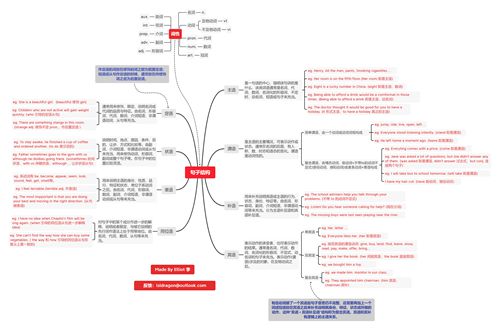基础语法系列(一) 句子结构
基础语法系列(一) 句子结构
前言
基础语法系列是我复习英语语法时做的笔记。整个内容以 思维导图 + 文字辅助解释 + 练习题 的形式展现。整个系列适合九年级及以上水平(或具有基本语法基础)观看。
思维导图相对与文字来说「更容易接受和记忆」,也便于知识体系的管理。整个系列的思维导图比较大,建议在电脑端观看。
在学习的过程中,一定要谨记:语法不能死记硬背,关键是理解。每个知识点最后都配有练习题来帮助理解,你也可以找更多的练习题来巩固,这样才不会遗忘。
学习语法短时间内并不会让你的英语水平有质的变化,但是一旦整个语法体系在你脑中形成,分析和写出任何长难句都是 a piece of cake.
系列不定式更新,可能一周一次。B站和微博同时更新。祝:学习顺利。
思维导图原图链接:
链接:
密码:k6dh
正文

句子结构
主语:是一句话的中心,指明该句讲的是什么,该类词语通常是名词、代词、数词、名词化的形容词、不定时、动名词、短语或句子来充当。
eg. Henry, All the men, pants, Smoking cigarettes ...
eg. Her room is on the fifth floor.(Her room 即是主语)
eg. Eight is a lucky number in China. (eight 即是主语,数词)
eg. Being able to afford a drink would be a comformat in those times. (Being able to afford a drink 即是主语,动名词)
eg. The doctor thought it would be good for you to have a holiday. (it 形式主语,to have a holiday 真正的主语)
谓语:是主语的主要情况,可表示动作或状态。通常在名词的后面,有人称、数、时态和语态的变化。谓语是动词性的。
简单谓语:由一个动词或动词词组构成。
eg. jump, ride, live, open, left ...
eg. Everyone stood listening intently. (stand 即是谓语)
eg. He left home a moment ago. (leave 即是谓语)
复合谓语:由情态动词,助动词+不带to的动词不定式(使役动词、感知动词)或者系动词+表语构成
eg. Everyting comes with a price. (come 即是谓语)
eg. Jane was asked a lot of questions, but she didnt answer any of them. (was asked 即是谓语, didnt answer 过去式,but conj. 连接两个句子)
eg. I will take bus to school tomorrow. (will take 即是谓语)
eg.I have my hair cut. (have 助动词,使役动词)
补语: 用来补充说明宾语或主语的行为、状态、身份、特征等。由名词、形容词、副词、介词短语、非谓语动词等来充当。分为主语补足语和宾语补足语。
eg. The school advisers help you talk through your problems. (不带 to 的动词不定式)
eg. Listen! Do you hear someone calling for help? (现在分词)
eg. The missing boys were last seen playing near the river.
宾语: 表示动作的承受者,也可表示动作的结果。通常是名词、代词、数词、名词化的形容词、不定式、动名词和句子来充当。表示动作(谓语)涉及的对象,在及物动词之后。
单宾语:
eg. her, letter ...
eg. Everyone likes her. (her 即是宾语)
双宾语:
eg. 接双宾语的谓语动词: give, buy, lend, find, leave, show, read, pay, make, offer, bring...
eg. I give her the book. (her 间接宾语,the book 直接宾语)
eg. we bought him a toy.
复合宾语:
有些动词接了一个宾语后句子意思仍不完整,还需要再加上一个词或短语放在宾语之后来补充说明其身份、特征、状态或所做的动作,这种“宾语+宾语补足语”结构称为复合宾语。宾语和宾补有逻辑上的主谓关系。
eg. we made himmonitor in our class.
eg. They appointed him chairman. (him 宾语,chairman 宾补)
同位语:对句子中的某个成分作进一步的解释、说明或者限定,与被它说明的先行词作语法上处于同等地位。由名词、代词、数词、从句等来充当。
eg. I have no idea when Chaplins film will be ong again. (when 引导的同位语从句进一步解释 idea)
eg. She cant find the way how she can buy some vegetables. ( the way 和 how 引导的同位语从句在意义上是一致的)
表语:用来说明主语的身份、性质、品行、特征和状态,常位于系动词之后。由名词、代词、形容词、数词、副词、介词短语、非谓语动词或从句等来充当。
eg. 系动词有 be, become, appear, seem, look, sound, feel, get, smell等。
eg. I feel terriable.(terrible adj. 作表语)
eg. The most impportant is that you are doing your best and moving in the right direction. (从句做表语)
状语:说明时间、地点、原因、条件、目的、让步、方式和比较等。由副词、介词短语、非谓语动词或从句来充当,用来修饰动词、形容词、副词或整个句子等。在句子中的位置比较灵活。
eg. To stay awake, he finished a cup of coffee and ordered another. (to do 表示目的)
eg. Father sometimes goes to the gym with us although he dislikes going there. (somethimes 时间状语,with us 伴随状语,although ... 让步状语从句)
定语:通常用来修饰、限定、说明名词或代词的品质与特征。由名词、形容词、代词、数词、介词短语、非谓语动词、从句等充当。
作定语的词放在修饰的词之前为前置定语;短语或从句作定语的时候,通常放在所修饰词之后为后置定语。
eg. She is a beautiful girl.(beautiful 修饰 girl)
eg. Childern who are not active will gain weight quickly. (who 引导的定语从句)
eg. There are something stange in this room.
(strange adj. 修饰不定 pron.,作后置定语 )
练习题
分析句子结构
The only means to achieve success is to appeal to arms.
The first people who were like ourselves lived so long ago that even their sagas, if they had any, are forgotten.
But there are some parts of the word where even now people cannot write.
Insects would make it impossible for us to live in the world.
I will be a different person when I live in England.
完

(基础语法系列(一) 句子结构)宝,都看到这里了你确定不收藏一下??